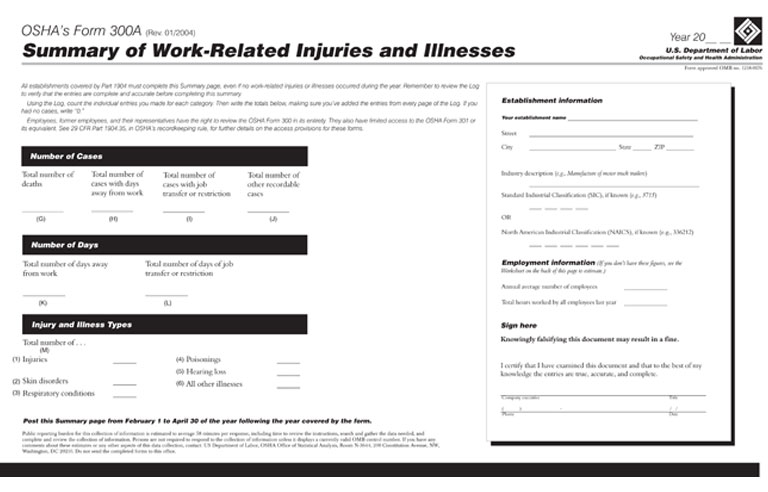OSHA FAQ’s
The OSHA law requires most employers with 10 or more full-time employees to keep a yearly log of all work-related injuries and illnesses. *This is the OSHA Log of Injuries and Illnesses, or the OSHA Form 300. We cover the common FAQ’s related to OSHA Form 300A, 300 & 301 below.
What is the OSHA Form 300?
The OSHA Form 300 is a form for employers to record all reportable injuries and illnesses that occur in the workplace, where and when they occur, the nature of the case, the name and job title of the employee injured or made sick, and the number of days away from work or on restricted or light duty, if any.
What is OSHA Form 300A?
OSHA Form 300-A is the Summary of Work-Related Injuries and Illnesses, which is to be posted in the workplace annually. At the end of each calendar year, Form 300-A must be completed and certified by a company executive as correct and complete and posted in the workplace where notices to workers are usually posted. It must be posted for three months, from February 1 until April 30.
What is OSHA Form 301?
OSHA Form 301 is called the Injury and Illness Incident Report, which is used to record information on how each injury or illness case occurred.
What Kinds Of Injuries Or Illnesses Should Be Reported On The Form?
Employers must record all new cases of work-related fatalities, injuries, and illnesses if they involve:
death,
days away from work,
restricted work or transfer to another job,
medical treatment beyond first aid,
loss of consciousness, or
a significant injury or illness diagnosed by a physician or other licensed health
care professional.
Each recordable injury or illness case must be recorded on the OSHA 300 Log and the Form 301 Incident Report within seven calendar days after the employer receives notice that the injury or illness occurred.
How are Injuries and Illnesses Recorded?
The OSHA 300 Log requires employers to check one of 6 boxes to categorize the injury/illness:
(1) injury
(2) skin disorder
(3) respiratory condition
(4) poisoning
(5) hearing loss
(6) all other illnesses.
There are spaces to record days of job transfer or work restriction, as well as days away from work. Calendar days (rather than scheduled work days) are used for recording days away from work. If an injury or illness causes a worker to miss work, the employer must record weekend days, holidays and other days that the worker might not have been scheduled to work. Employers may limit days away from work to 180 days.
How are Privacy Issues Handled?
There are certain cases in which an injury or illness is handled as a privacy case and thus are handled confidentially.
Employers are prohibited from entering an employee’s name on the OSHA 300 Log in the following cases (considered “privacy cases”):
the injury or illness occurred to an intimate body part or the reproductive system; sexual assaults;
mental illnesses;
HIV infection, hepatitis, or tuberculosis;
and needlestick injuries and cuts from sharps where the objects are contaminated
with another person’s blood.
In these privacy concern cases, a separate confidential list of employee names must be kept. Employers also have the right to use discretion in describing the sensitive nature of the injury where the worker’s identity would be known.
Which Employees Are Covered By The Recording Requirements?
All employees on the payroll are covered.
The employer is required to record on the OSHA 300 Log the recordable injuries and illnesses for all employees on its payroll, including hourly, salaried, executive, part-time, seasonal, or migrant workers. The employer must also record injuries and illnesses that occur to workers who are not on the employer’s payroll if the employer supervises theseworkers on a day-to-day basis (including employees of temporary help services, employee leasing services, personnel supply services and contractors).
How Long Must the Forms Be Kept?
Five Years
Employers must save the OSHA 300 Log, the Form 300-A (annual summary), privacy case lists, and the Form 301 Incident Report forms for five years. The stored OSHA 300 Logs must be updated by the employer to include any newly discovered recordable injuries or illnesses.
Do Employers Also Have to Phone OSHA to Report Injuries and Illnesses?
Only in certain cases – in the event of a work-related fatality or if three or more employees are hospitalized as the result of a work-related incident (i.e. a chemical release in the plant.)
Within eight hours after a work-related death of an employee or the hospitalization of three or more employees from a work-related incident, the employer must report the fatality or multiple hospitalizations by phone or in person to the nearest Area Office of OSHA.
Are Workers Allowed to See These Forms?
Yes. Employers must provide copies of the OSHA 300 Logs and Form
301 Incident Report free of charge (if duplicate copies of the same form are requested, he employer may charge copying costs). Once a request is made, these documents must be provided by the end of the next business day.
Upon request, employers must provide workers, former workers, their personal representatives, and their authorized employee representative (union representative) access to injury and illness records. The names of employees must be left on the OSHA 300 Log unless they are “privacy concern cases.” Employers may not use the Health Insurance Portability and Accountability Act (HIPAA) as a basis for removing employee’s names from the Log before providing employees’ access.
Employees, former employees, or personal representatives must be given a copy of a requested Form 301 Incident Report by the end of the next business day.
The only exception is when an authorized employee representative (union representative) asks for a copy of the Form 301 Incident Report. The employer is only required to give copies of the part of the form that contains information about the case, with all personal information about the employee removed, within seven calendar days.
What if Workers Are Scared to Report Their Injuries and Illnesses?
It is illegal for employers to discriminate or harass workers for reporting
an injury or illness.
Section 11(c) of the OSH Act prohibits employers from discriminating against a worker for reporting a work-related death, injury or illness, filing a safety and health complaint, asking for access to injury and illness records, or for exercising any other rights under the OSH Act. Many employers have “safety incentive” and “injury discipline” programs that could violate OSHA’s Section 11(c) anti-discrimination provisions. Under these incentive and discipline programs, workers who report injuries may be denied some type of reward or may be automatically placed on a discipline tract or drug-tested. Local unions may want to consider filing OSHA 11(c) complaints of discrimination if members have suffered such discrimination after reporting an injury or illness.
Are Musculoskeletal Disorders (MSDs) Reported on OSHA 300 Logs?
Yes, however, there is no separate column to report, check off, MSDs on
the OSHA 300 logs. They are lumped in with “all other illnesses…”
MSDs, like other workplace injuries and illnesses, must be recorded if an “event or exposure in the work environment either caused or contributed to the resulting condition or significantly aggravated a pre-existing injury or illness.” When the Clinton administration designed the new OSHA 300 Logs, there was a separate column for MSDs on the form. However, under President Bush, OSHA has eliminated the column for recording MSDs. MSDs which include back injuries, tendonitis, and carpal tunnel syndrome still have to be recorded, but they are lumped in with “all other illnesses”, or are simply recorded as an injury, making it much more difficult to identify and correct the working conditions that cause these problems. A description of the disorder must be entered in column F, therefore it is necessary to read all of the descriptions in column F in order to gather information regarding MSDs.
How are OSHA 300 logs useful to UFCW members and local unions?
OSHA 300 Logs are valuable tools for workers and local unions to use in evaluating the types, frequency and severity of workplace injuries and illnesses. This information, in turn, can be used to identify the location and nature of workplace hazards that should be eliminated or controlled.
OSHA 300 Logs, however, do not provide a complete and accurate accounting of all the injuries and illnesses experienced in a workplace. Not all injuries and illnesses are required to be recorded. The following are examples of injuries and illnesses that may not be recorded on an OSHA 300 Log:
a) an assault on a worker by a patient or client that does not result in treatment of more than first aid,
b) musculoskeletal disorders that an employer does not accept as work-related,
c) early signs and symptoms of some musculoskeletal disorders,
d) many occupational illnesses (cancer and other illnesses) that an employer does not accept as work-related,
e) work-related stress, and
f) injuries which result in lost time or restricted activity only for the day of the incident.
In addition, employer policies, programs and practices may discourage workers from reporting injuries and illnesses. Safety incentive programs that offer prizes to workers who do not report injuries and injury discipline policies that threaten discipline to workers who do report, have both been shown to decrease the reporting of workplace injuries and illnesses. Local unions should use additional methods to identify symptoms, injuries and illnesses that are occurring in the workplace. These may include worker surveys, body mapping, and requesting additional information, (like worker compensation data, data from medical clinic visits, and results of hearing tests).
The OSHA standard that requires these injury and illness records to be maintained is 29 CFR 1904. The entire standard can be accessed by going to the OSHA website, www.osha.gov. Click on Regulations, and then Part 1904, Recording and Reporting Occupational Injuries and Illnesses.
*NOTE: Workplaces such as beauty and barber shops, retail clothing and furniture stores, eating and drinking establishments, drug stores and, shoe repair stores are exempt from keeping OSHA 300 Logs.
Disclaimer : This material on OSHA Form 300A 300 301 was produced under grant SH-22246-11-60-F-11 from the Occupational Safety and Health Administration, U.S. Department of Labor. It does not necessarily reflect the views or policies of the U.S. Department of Labor, nor does mention of trade names, commercial products, or organizations imply endorsement by the U.S. Government.
Reference : www.osha.gov
Download FAQ’s on OSHA Form 300A, 300 & 301 as a PDF. Click here.
Helpful training : OSHA Recordkeeping Requirements and Electronic Submission Guidelines 2020
In this live webinar, you will learn:
- What the OSHA 300 log electronic recordkeeping requirements are through the Injury Tracking Application (ITA) website
- How to easily navigate the new OSHA 300 log electronic reporting system
- How to fill out the OSHA 300 Logs, including the OSHA 300, 300A, and 301 Forms
- How to effectively determine work relatedness as it pertains to OSHA recordkeeping
- The difference between First Aid versus Medical Treatment
- How to address difficult site-specific OSHA recordkeeping scenarios
- How to address any site-specific questions or concerns
- How to get started in implementing a comprehensive OSHA recordkeeping program at your site
- How to stay informed of ongoing changes in the OSHA recordkeeping requirements
- What are some resources that can be helpful with OSHA recordkeeping




